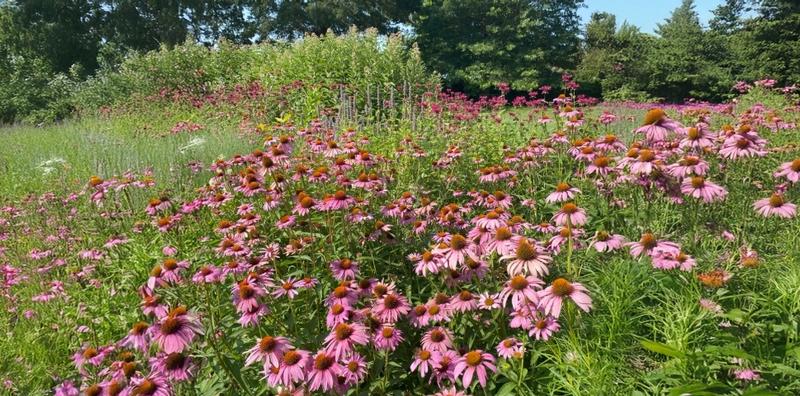Watching for Signs
Even in the face of record heat, the signs are there, native plants are making a difference. Small efforts ripple outward. Together, we make waves!
Signs that it's working
Ever wonder whether all the work - the research, the preparation, the convincing of the indifferent - if its worth it? If all the things native plant folks claim native plants do actually works?
Do you sometimes just need reassurance that all this ‘plant native plants’ stuff is worth the effort?
In the face of the recent Heat Dome that blanketed a portion of the US, trying to convince people why it's relevant to choose native plants can feel like an uphill slog. That every little action we take to care for the environment is worth it. Sometimes, we need a reminder of why we do what we do. While strolling through some gardens, we noticed subtle signs that all this habitat creation was coming together. If we can see it in a small microcosm, then we can extrapolate the change as we compound each other's efforts and boost their effect at a larger scale. We are all but ripples in a pond, but together, we make waves.
Example one: Build it and THEY WILL COME
We often repeat the adage, “build it and they will come.” In this case, we mean that if you prepare the ground through conscientious soil care, plant selection, and habitat creation, wildlife that was previously assumed to be dead or gone will trickle back in. Usually, the signs aren’t flashy and can be difficult to discern. It’s a pest being parasitized, a songbird building a nest when the garden used to be quiet, the zipping of a bat, and the slow flickering of a firefly that hasn’t been seen in years. We encourage everyone to look for them during routine site visits, to celebrate the activation of dormant relationships and the restoration of an ecosystem’s balance.
Example Two: Completely unbothered
In the blistering heat of the heat dome, many plants were struggling, such as this Hydrangea macrophylla, which required extensive special attention and water to survive the stress. These same non-native plants required extra protection this winter, as an unexpected cold snap was expected to kill the overwintering flowering buds. Meanwhile, well-adapted native plants required no additional irrigation during this heat wave nor protection during the winter cold snap, thriving in the face of extremes. The effort of selecting hardy plants that can withstand environmental challenges is worth it, especially when thorough research at the beginning results in fewer maintenance hours later.
Example Three: Problem SOLVED
Frequently, we receive emails about a problem in the landscape that’s detracting from the garden’s appeal. Whether it is rampant pest pressure, the spread of disease, or seasonal moisture issues, it seems like everything is trying to get a piece of the action. Much in the same vein as “build it and they will come”, seeing problems get solved through matching plants with their site conditions and the area’s needs, along with time, is undeniably satisfying.
Watching for Signs
While all these signs are anecdotal at best, as no baseline was taken and no rigorous quantitative measurements were conducted across multiple samples, it is still heartening to look around and see a measure of success in the face of losses. The signs aren’t big or extravagant, and they can vary with the season, but they are there. When a client goes from having only cardinals in the garden to bobtail whites, thrashers, and hummingbirds, or no fireflies to hundreds, or sopping drainage issues to just a wet spot in the yard, these are success stories. Change occurs in increments, slowly and steadily, over time. When at first their tomatoes were overrun with tomato hornworm, but after the installation of a nearby pollinator garden, there’s hardly a hornworm in sight (or when your client does see them, they are parasitized by wasp larvae), that is a sign that the ecosystem is coming back into equilibrium.
When you show clients that the shade tree planted near the house reduces air conditioning needs by 15-50%. The pollinator garden and pond attract bats and dragonflies, thereby reducing the damage caused by spraying for mosquitoes. The reduced lawn area in exchange for native plantings mitigates stormwater issues and decreases the fuel cost associated with weekly mowing. It all adds up. Each choice and action are worth the effort, even in the face of looming weather extremes. Choosing plants that can thrive in extreme conditions and support the larger ecosystem is beneficial, even if the benefits are subtle and small, even if the best sign you’ve got is the absence of the original headache. It’s hard to see an assassin bug eating a pest on a rose or remember that a client used to have flooding issues, but they are there, waiting for us to notice and take heart. So, in the heat of the summer, when you’re questioning how you chose to be outside when it's nearly 100F out, remember we’re doing it for the small things that no one sees. Watch for the signs.


